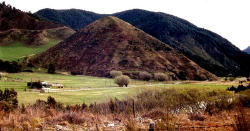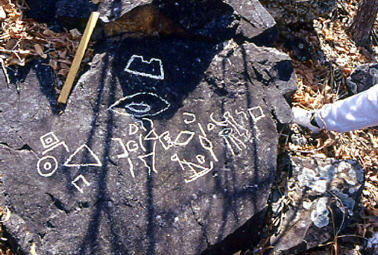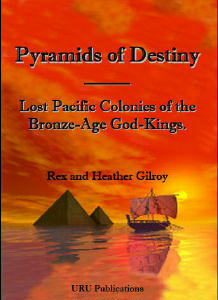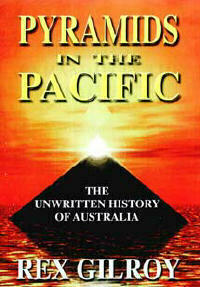
| Pyramids of Destiny – Lost Pacific Colonies of the Bronze-Age God-Kings |
 |
The Egypto-Phoenician rock inscription found just below the summit of the west face of the pyramid. It states: “The mines in the mountains are watched over by Ra, Eye of the Sun as he rises over the ocean to shine even in winter.
He cares for the land with his light. Ta-na, our King, the dark-haired, arrived here by the ‘Ship of the Royal Banner’. He officiates at the pyramid and rules over the mines of shining gold and copper”.
|
Pyramids of Destiny – Lost Pacific Colonies of the Bronze-Age God-Kings
by Rex & Heather Gilroy
Copyright
© Rex Gilroy 2009
“Australian history is almost always picturesque; It does not read like history but like the most beautiful lies. Mark Twain: Following the Equator [1891] |
”Every truth passes through three stages before it is recognised. Arthur Schopenhauer [1788-1860] |
Part Three.
Lost Egypto-Phoenician Colonies of Queensland’s Far North.
Chapter Twenty.
Rex and Heather Gilroy – Uncovering the Lost Mining Kingdom of Pharaoh Tana.For thirty five years now, Heather and I have been making continual expeditions into the jungles of Queensland’s rugged, rainforest and scrub-covered Far North, our goal being to uncover what has to have been the largest Egypto-Phoenician kingdom and mining colony ever established in this state.
Its sheer size alone suggests that those who ruled over it must surely have also been responsible for the establishment of other colonies further south and also probably those to be found on mineral-bearing Melanesian islands across the Coral Sea, including New Guinea. We may only speculate for now.
The amount of evidence so far uncovered by us is far too much for a single chapter, as the reader is about to find out. How could we have known when we obtained our first leads back in 1978, that our search would lead us to explore coastal creeks and rivers infested with ‘salties’, and dense jungle vine-hanging rainforests, in search of rock inscriptions and megalithic ruins, often following vague directions provided by old-timers.
Often all we have had to go on have been stories dating back to the 19th century; stories of mystery stone ruins of probable temples, and stories hoary with time of ‘lost’ crumbling stone pyramids hidden deep in jungle. Sometimes their locations are a closely guarded secret of local Aboriginal people, for these ruins are the remains of the “old ones” who came among their people from across the ocean thousands of years ago. Like Heather and I, they guard the secret of the locations of these monuments with just cause.
Can you imagine the fate of such structures at the hands of unscrupulous would-be “treasure-hunters”, tourism promoters and vandals? Our opinion since the destruction of the Gympie Pyramid is that, the Australian public is not yet enlightened enough to be shown these enigmas of our unknown past.
It was in fact a pyramid which led Heather and I to discover the great, vast Far North Queensland Egypto-Phoenician colony. The story begins on our 1978 Queensland archaeological expedition. We had been drawn to Cairns in search of information concerning the famous discovery, by Mr Andrew Henderson in 1910, of a Ptolemy 4th bronze coin, unearthed by him in the Kuranda jungles [more on this in a later chapter].
Our quest led us to Mr Joe Martin [since deceased] of Cairns who provided us with directions to meet the then present owner of the coin. It was in the course of discussions on the research that we were involved in that Joe mentioned the discovery, high up in the Atherton Tableland jungles 100 years before, of a structure which had become known as the “Lost Pyramid of Far North Queensland”.
The story was that a Cooktown farmer, while clearing rainforest in a remote area in the mid-19th century, had uncovered a mysterious, crumbling stepped stone structure. It would later be visited by a few local settlers until the jungle reclaimed it and the location became lost with the dying off of the old pioneers.
Old Joe martin could only provide us with the vaguest of directions and wished us ‘good luck’ in our quest, before we headed off on what was to become a twelve year long search, when in September 1987, we stumbled upon what may or may not be the same pyramid.
The structure found by us is now a crumbling ruin, built of iron ore, quartz and other rocks of varying sizes, weighing as much as 2 to 4 tonnes, through which centuries of trees have grown to dislodge much of the stonework. The pyramid, which faces the four cardinal points of the compass, stands 18.3m tall, consisting of eight terraces each of varying height, the base terrace being 2m tall by 30.5cm square.
The summit is flat, measuring 14m length by 5m in width within the remains of an enclosing rubble wall. There is evidence that the entire structure was once coated in a white cement-like mixture. At the eastern side of the summit enclosure we found a massive stone, a former altar, which in the course of time had rolled over due to erosion of the eastern base. Now resting on the eastern summit edge of the pyramid, the stone measured 2m in width by 1.53m tall when standing upright, by 2.14m in length.
Extending out from the pyramid base and enclosing it on all four sides, we discovered the crumbled remains of a low stone rubble wall measuring 60m square, an entrance in the form of a 1.3m width gap being found near its north-west corner. Further up the south side of the pyramid we noticed the ruined remains of a 4.5m width ‘Stairway’ to the summit, the steps having long ago crumbled away.
13.5m distant we discovered another former stairway, divided down the centre by a low wall, leading from the summit to the base, into an enclosure, now only of rubble, which we measured at 5.5m length by 5.6m width, the rubble outline, like the outer wall enclosing the pyramid being 53cm in height. It appeared to us that here had stood two small shrines, their images long vanished with time.
Clearing away dead bracken at the north-east corner of the outer wall, I found a small section of wall 1.8m in height, the probable original height of this wall, supported by the amount of fallen rubble now lying about its surviving remnants today. Our time had run out on this trip and we had to head for home. Returning to Far North Queensland in July 1990 we resumed our investigation of this structure.
To our surprise a bad drought was in progress, causing a die-off of much of the jungle coating of the relic, which had all the features of a ceremonial pyramid. We searched the surrounding terrain, the dried-out forest making our task easier, and as we were here in winter we felt safe, as this is not an area to roam about in the summer months owing to the many Taipans and other deadly snakes that inhabit the Atherton Ranges.
Heaps of smelted slag lay scattered over a wide area, and there were traces of open-cut mining, obviously for alluvial gold, as I stumbled upon an area covering many hectares of ground showing unmistakable open-cut operations for this purpose, the entire region covered in piles of quartz. Indeed, quartz litters the countryside hereabouts and the training I had received from my father [since deceased], an old miner, told me that here was a very rich gold-bearing region, mined thousands of years before the coming of European settlement to these shores.
Main Book Index | Mysterious Australia Homepage | URU Homepage | Australian Yowie Research Centre

